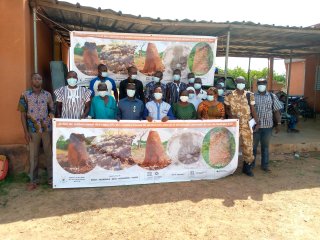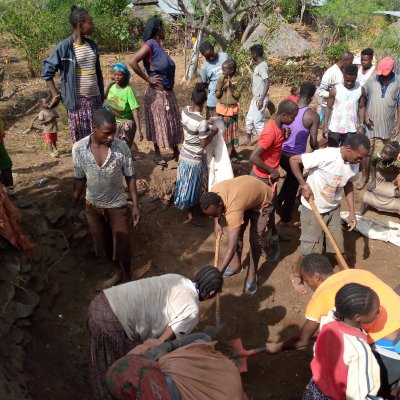#SOSAfricanHeritage
UNESCO World Heritage Ancient Ferrous Metallurgy Sites of Burkina Faso: Training for a Better Protection of the Sites
In order to improve the management of Burkina Faso's Ancient Ferrous Metallurgy Sites and thus promote their conservation, training was provided to the Sites' local management committees.
The programme
The aim of #SOSAfricanHeritage is to contribute to preserving independent and sustainable organisational structures at African World Heritage Sites and Biosphere Reserves with the participation of civil society as well as to secure spaces dedicated to education for global citizenship, sustainability and cultural diversity.
The World Heritage Site consists of five sub-areas in different provinces of Burkina Faso and includes a total of 15 preserved furnaces, several furnace structures, mines and traces of dwellings that provide information about the millennia-old iron smelting in Africa. The furnaces are shaft furnaces built of clay or stones, approximately 50 to 220 cm high, which were used for iron extraction.
The sites are an outstanding example of the diversity of traditional iron ore smelting methods in Burkina Faso. Their development had a major impact on African history from the 8th century BC on. Since the 11th century AD, iron smelters developed into mass production sites of which remaining furnaces bear witness to this day. The furnaces are for the most part nearly completely preserved and vary in shape and design. Traces of the processing of iron ore with huge accumulations of slag can still be seen today. Through the continuation of traditional rites and social practices, blacksmiths still play an important role in the village communities of Yamané, Kindibo and Douroula, where some of the preserved furnaces are located.
Restrictions due to the pandemic
The preservation of the sites is threatened by several interacting factors, which were exacerbated by the outbreak of the Covid-19 pandemic. These include the encroachment of the land directly surrounding the sites by agricultural use, the free grazing of animals at the historic ovens, the erosion by rainwater, and the spread of harmful plant species in the area of the sites. These various threats described in the Sites' management plan were supposed to be addressed by a series of concrete measures. However, the Ministry of Culture, Arts and Tourism, and thus also the Directorate of World Heritage Sites, had been deprived of the financial resources to implement the annual work plan, as the government needed the funds for its fight against the Covid-19 pandemic.
Remedy through training and visibility
The aim of the project funded by #SOSAfricanHeritage was to promote the conservation of the five sub-areas of the Ancient Ferrous Metallurgy Sites in Burkina Faso and thus preserve their universal value. To this end, the skills and capacities of the local management committees responsible for the conservation of the sites were built and the visibility of the sites was increased.
The Directorate for World Heritage Sites trained the members of the local management committees to enable them to sensitise the local population to the protection of the sites and to carry out the necessary maintenance and preservation measures themselves, such as pruning trees and fulfilling regular maintenance tasks.
In addition, signs were erected at the Sites explaining the historical significance of the respective sub-area. In this way, the Directorate aimed to promote a better understanding of the value of the Sites among the local population and thus ensure their preservation in the long term.
The consortium
On the initiative of the Federal Foreign Office and the Goethe-Institut, an International Relief Fund was set up in summer 2020 to provide rapid support to cultural and educational organisations abroad during the Covid-19 pandemic. With its special support programme #SOSAfricanHeritage, the German Commission for UNESCO is part of the Relief Fund consortium.
The project
- Site: Ancient Ferrous Metallurgy Sites
- Country: Burkina Faso
- Type of Site: UNESCO World Heritage Site (cultural heritage)
- Year of inscription: 2019




